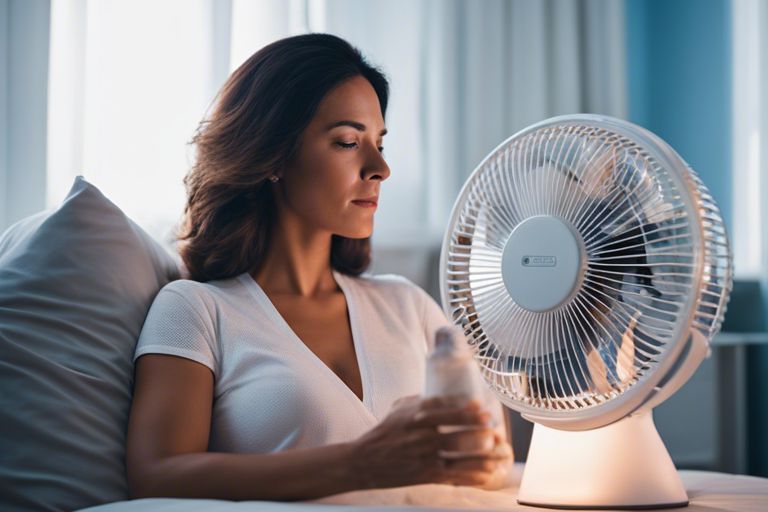Hot flushes, a common symptom of menopause, can be challenging to manage but with the right tips and tricks, staying cool during these episodes is possible. This blog post aims to provide insightful advice on how to navigate hot flushes and maintain composure. From choosing breathable fabrics to staying hydrated and managing stress levels, these simple yet effective strategies can help women experiencing hot flushes feel more comfortable and in control. By incorporating these tips into your daily routine, you can better cope with hot flushes and feel confident in handling this natural phase of life with ease.
Key Takeaways:
- Stay Cool: Wear lightweight, breathable clothing to help manage hot flushes.
- Hydration is Key: Drink plenty of water to stay hydrated and regulate body temperature.
- Manage Stress: Practice relaxation techniques such as deep breathing or yoga to reduce the frequency of hot flushes.
- Avoid Triggers: Identify and avoid triggers such as spicy foods, caffeine, and alcohol that can worsen hot flushes.
- Seek Support: Connect with others going through similar experiences for advice and emotional support.
Identifying Triggers
Dietary Influences
Many women find that certain foods and drinks can trigger hot flushes. Common culprits include spicy foods, caffeine, alcohol, and hot beverages. Keeping a food diary can help identify which items worsen your symptoms, allowing you to make informed choices about what you consume.
Environmental and Lifestyle Factors
Environmental factors such as high temperatures, humidity, and stressful situations can also contribute to hot flushes. Lifestyle habits like smoking, lack of physical activity, and wearing tight clothing may exacerbate symptoms. It’s crucial to pay attention to your surroundings and daily routines to pinpoint potential triggers.
- Avoiding hot, crowded places can help reduce the frequency of hot flushes.
- Wearing loose, breathable clothing can aid in maintaining a cooler body temperature.
The key to managing hot flushes is understanding what sets them off. By identifying triggers like dietary influences and environmental/lifestyle factors, you can take proactive steps to minimise their impact on your daily life.
Practical Strategies for Relief
Dressing for Comfort
Choosing the right clothing during hot flushes can make a significant difference in your comfort levels. Opt for loose, breathable fabrics such as cotton or linen to allow air circulation and prevent overheating. Layering is also key, as you can easily remove or add clothing as needed. Avoid synthetic materials that trap heat and stick to the skin, exacerbating symptoms.
Quick Cooling Techniques
When a hot flush strikes, having quick cooling techniques at your disposal can provide much-needed relief. Keep a handheld fan in your bag for instant cooling, or try applying a cool damp cloth to your neck or wrists. Drinking cold water or using a cooling spray can also help regulate body temperature during a hot flush.
Long-term Management
Beneficial Lifestyle Changes
Embracing beneficial lifestyle changes can significantly help in managing hot flushes in the long term. Simple adjustments like maintaining a healthy weight, staying hydrated, avoiding triggers such as spicy foods and caffeine, and practising relaxation techniques like yoga or meditation can all contribute to reducing the frequency and intensity of hot flushes.
When to Seek Medical Advice
If hot flushes are significantly impacting your quality of life, it may be time to seek medical advice. Persistent hot flushes that interfere with daily activities, disrupt sleep, or are accompanied by other concerning symptoms like irregular bleeding or severe mood changes should not be ignored. Consulting a healthcare professional can help in exploring possible underlying causes and suitable treatment options.
Navigating Hot Flushes – Tips and Tricks for Keeping Cool
In brief, managing hot flushes can be challenging, but with the right strategies, it is possible to stay cool and comfortable. Simple lifestyle changes such as staying hydrated, dressing in layers, and practising relaxation techniques can make a significant difference in reducing the frequency and severity of hot flushes. It is important to remember that hot flushes are a common symptom of menopause and not something to be ashamed of. By implementing these tips and tricks, individuals can navigate hot flushes with more ease and continue to enjoy their daily activities without disruption.
FAQ
Q: What are hot flushes?
A: Hot flushes, also known as hot flashes, are sudden feelings of warmth that are usually most intense over the face, neck and chest. They can also cause sweating and a rapid heartbeat. Hot flushes are a common symptom of menopause, but can also be caused by medical conditions or certain medications.
Q: How long do hot flushes typically last?
A: The duration of hot flushes can vary from person to person. Some individuals may experience hot flushes for a few months, while others may experience them for several years. On average, hot flushes tend to last for about 2-3 years during menopause, but they can persist for longer in some cases.
Q: What triggers hot flushes?
A: Hot flushes can be triggered by a variety of factors, including stress, hot weather, spicy foods, alcohol, caffeine, and smoking. Hormonal changes during menopause are the primary cause of hot flushes, as the body’s oestrogen levels fluctuate.
Q: How can I stay cool during a hot flush?
A: To stay cool during a hot flush, you can try wearing lightweight, breathable clothing, using a fan or air conditioning, drinking cold water, and practising deep breathing techniques. It may also help to keep a portable fan or cooling spray handy for immediate relief.
Q: Are there any lifestyle changes that can help reduce the frequency of hot flushes?
A: Yes, there are several lifestyle changes that may help reduce the frequency of hot flushes. These can include maintaining a healthy weight, staying active, managing stress through relaxation techniques, avoiding triggers such as spicy foods and alcohol, and ensuring you get enough sleep.






